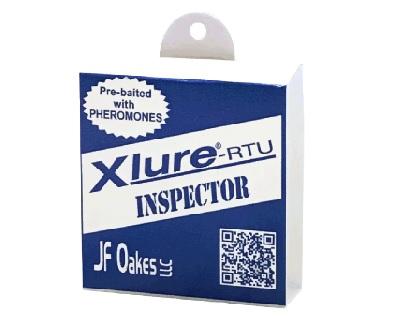
When you need to rapidly pinpoint the source of infestation, you can depend on Xlure RTU Inspectors. This compact, ready-to-use pheromone monitoring trap measures 2.5” x 2.5” x 0.75” and is designed to release a low level of pheromones allowing a large number of traps to be installed in a small area without causing mating disruption. Using many traps in warehouses and food storage and processing plants allow the technician to quickly pin-point insect hot spots.
XLure RTU Inspectors are pre-baited with pheromones which begin attracting target insects when the release paper is removed from the glue surface.
Insects Attracted:
- Indian Meal Moth: Plodia interpunctella
- Almond Moth/ Cocoa Moth: Ephestia cautella
- Raisin Moth: Cadra figulilella
- Tobacco Moth: Ephestia elutella
- Mediterranean Flour Moth: Ephestia kuehniella
- Cigarette Beetle: Lasioderma serricorne
Instructions for Use:
Thoroughly inspect the account and identify potential infestation hot- spots and mark them on a site plan or map. The positioning of the monitors can be marked on this map once they are installed to facilitate
the reading of catch levels.
Installation:
Expose glue area by removing the release paper. Fold monitor at each of the 4 scores along the trap so that the monitor forms a box shape. Secure trap closed by overlapping the glue on one end of the trap over opposite end.
Xlure RTU Inspectors can be hung by the hole-punched tab at the top of monitor or they may be secured to a surface using the double stick tape on the back side of the trap.
Placement of monitors can affect the amount of insects that will be caught. For an effective program, it is important that the traps are placed in the best position possible. When monitors are replaced, be sure that the positioning is altered as little as possible so that information from different times of the year can be compared accurately.
Regular Inspections:
The sensitivity of area dictates how often monitors should be inspected. In commercial accounts with a zero insect tolerance, frequent monitoring is recommended. Residential accounts may be inspected quarterly or when other services are rendered. Whatever the frequency monitors are checked, it should be kept consistent so that monitoring records can be compared accurately.
Replacement:
Xlure RTU INSPECTORS should be replaced every 4 – 6 weeks. Care should be taken during inspections to check the condition of the glue area, especially in dusty environments or high insect catch situations as these can cause the glue area to deteriorate. Should this occur, replace the monitor.
Good results can be obtained by following a few guidelines:
- If possible, positions should be chosen that offer shelter for the trap.
- Wherever possible, place units where moths are likely to fly or have been seen.
- Ensure that cleaning and janitorial staff are informed of the program to prevent trap removal & contamination. Mark the position of the traps on a site plan and allocate a number to each trap.
- Never store monitoring traps with pesticides/insecticides Wash hands before installing, inspecting and replacing traps.
- Avoid placing traps in areas where large volumes of air are moving out of the building.
Watch our XLure R.T.U. Inspector video:
http://www.jfoakes.com/wp-content/uploads/2019/03/XlureInspector_JeffMcGovern2.mp4?_=1
Specific Insect Info
Indian Meal Moth:
Almond/Cocoa Moth:
Mediterranean Flour Moth:
Raisin Moth:
http://www.jfoakes.com/product-category/stored-product-insects/stored-product-moths/raisin-moth/

